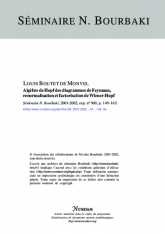Exposé Bourbaki 900 : Algèbre de Hopf des diagrammes de Feynman, renormalisation et factorisation de Wiener-Hopf
Exposé Bourbaki 900 : Hopf algebra of the Feynman diagrams, renormalization and Wiener-Hopf factorization

- Consulter un extrait
- Année : 2003
- Tome : 290
- Format : Électronique
- Langue de l'ouvrage :
Français - Class. Math. : \hbox {81-xx}, 81S40, 58D30
- Pages : 149-165
- DOI : 10.24033/ast.607
La théorie quantique des champs perturbative fournit des séries asymptotiques d'intégrales divergentes. La renormalisation a pour objet d'attribuer à ces intégrales, de façon cohérente, des valeurs numériques précises (parties finies). A. Connes et D. Kreimer ont proposé une méthode mathématiquement limpide et universelle pour accomplir ce programme : les diagrammes de Feynman qui repèrent les termes de la série sont organisés en algèbre de Hopf graduée, et la série renormalisée se déduit d' une factorisation de Wiener-Hopf de la série perturbative, réinterprétée comme fonction (lacet) $\gamma (\mu ,\varepsilon )$ à valeur dans le groupe formel associé (dépendant d'une unité de masse $\mu $ liée à la graduation, et d'un paramètre $\varepsilon $ (dimension) servant au prolongement analytique).

